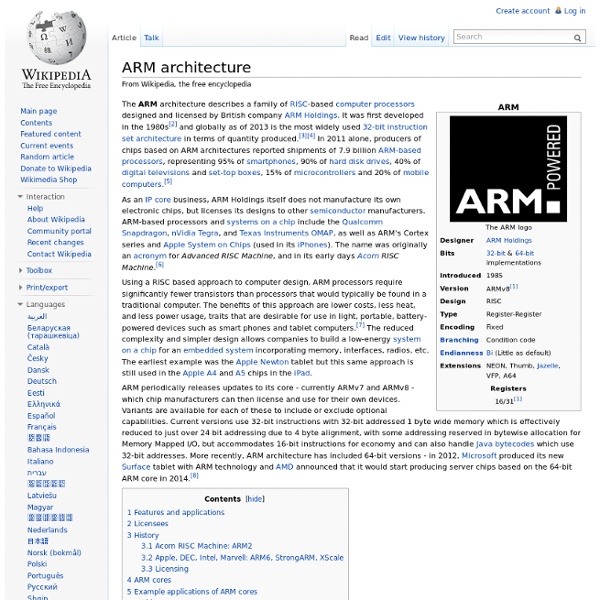



GTA04 News: There is a new mailing list dedicated to the early adopters of this project: general discussions should be continued on the Openmoko Community lists: The codename GTA04 was picked up in 2010 by Golden Delicious Computers to develop a new motherboard for our open smartphone that follows the original idea and goals. There is a new project page: which houses the wiki specific to the GTA04 project at Golden Delicious. GTA04A4 is a new motherboard, that replaces the one inside your Neo 1973 (GTA01) or Neo Freerunner (GTA02). The GTA04A4 motherboard PCB layout development is based on GTA04A3 and its start was announced at 7 October 2011. The replacement, populated GTA04, motherboard is available at Golden Delicious. On 14th November 2011 GTA04A4 boards became available for (pre)order. History Year 2011: GTA04A3 (Early Adopter) Video: Specifications Videos: New:
Patented Dual-Crossbar Architecture for 32-bit ARM Microcontrollers Silicon Labs’ Precision32™ mixed-signal 32-bit microcontroller devices use a patented dual-crossbar architecture that allows designers to choose peripherals and pinout placement without worrying about pre-set limitations and pin conflicts — simplifying PCB routing, minimizing PCB layers and ultimately reducing design time and system cost. Here's what sets the 32-bit ARM microcontroller apart from the rest: Put Practically Any Peripheral On Any Pin Using Silicon Labs’ patented dual-crossbar technology and a drag-and-drop GUI, developers can easily choose their analog and digital peripherals and pin locations for these peripherals. Last-minute changes are not a problem. The AppBuilder utility provides unprecedented flexibility in choosing the exact peripherals needed for the application, even with the smallest, lowest-pin count packages. Integrated Analog with No Compromise Performance Smart Integration — Highly-Integrated Peripherals Low Power Consumption
Openmoko Beagle/Panda Hybrid - Beagleboard or Pandaboard with Openmoko Display News: We have been choosen by the PandaBoard Early Adopter Program and will receive a PandaBoard (OMAP4 / ARM Cortex A9) board soon. The Openmoko Beagle/Panda Hybrid is a PCB to connect an Openmoko Freerunner display (TD028TTEC1) through some connectors with a Beagle or Panda Board. It became the basis for a new Openmoko device and can therefore also be referenced as "GTA04A1". Please go to the specific sub-projects U-Boot for OMBKernel for OMBDebian Lenny for OMB We encourage to port/configure Android, Angstrom, QtMoko, SHR, and other distributions. Please find instructions at Debian Lenny.
Math, Physics, and Engineering Applets Oscillations and Waves Acoustics Signal Processing Electricity and Magnetism: Statics Electrodynamics Quantum Mechanics Linear Algebra Vector Calculus Thermodynamics Mechanics Miscellaneous Licensing info. Links to other educational sites with math/physics-related information or java applets useful for teaching: And when you get tired of learning, here is some fun stuff: Pong Simulation Circuit-level simulation of original 1972 Pong. ECE4803B: Theory and Design of Music Synthesizers Instructor: Prof. Aaron LantermanOffice: Centergy 5212 (often) or Bunger-Henry 323 (rarely) Phone: 404-385-2548 E-mail: lanterma@ece.gatech.edu Course website: users.ece.gatech.edu/~lanterma/ece4803 When and where: MW, 4:30-6:00, Van Leer C457 (sent via real-time video link to GTREP) The photo: Aaron in the beginning stages of putting together the MOTM-485 VCF, which is based on the diode-ring Sallen-Key filter from the Yamaha GX-1 (in case you're wondering, the answer is yes, I am the only prof on my floor with a soldering iron!) Lectures may be downloaded as RealPlayer files.
Curious Inventor Blog - How To: Make Cheap LaserCut Custom Boxes for Your DIY Electronics